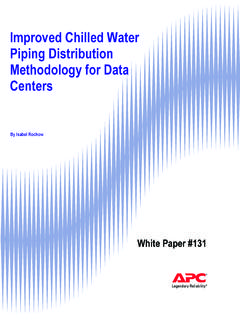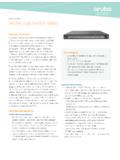Transcription of Guidelines for Specifying Data Center Criticality / …
1 Guidelines for Specifying data Center Criticality /. Tier Levels By Victor Avelar White Paper #122. Executive Summary A framework for benchmarking a future data Center 's operational performance is essential for effective planning and decision making. Currently available Criticality or tier methods do not provide defensible specifications for validating data Center performance. An appropriate specification for data Center Criticality should provide unambiguous defensible language for the design and installation of a data Center . This paper analyzes and compares existing tier methods, describes how to choose a Criticality level, and proposes a defensible data Center Criticality specification. Maintaining a data Center 's Criticality is also discussed. 2007 American Power Conversion. All rights reserved. No part of this publication may be used, reproduced, photocopied, transmitted, or 2.
2 Stored in any retrieval system of any nature, without the written permission of the copyright owner. WP122 Rev 2007-0. Introduction Terms like availability, reliability, mean time between failure (MTBF), and others are oftentimes used interchangeably to describe data Center performance. These terms are quantitative measures of performance that are difficult for data Center managers to calculate. An alternative and simplified approach is to categorize data Center performance in tiers or Criticality levels. This paper proposes that the term Criticality be used to subjectively describe data Center performance. A data Center 's Criticality has arguably the strongest influence on lifetime total cost of ownership (TCO). For example, a fully redundant (2N) power architecture could more than double the 10-year TCO of a non- redundant (1N) power architecture.
3 Although a significant cost penalty for 2N power is the doubling of electrical equipment capital costs, the greater impact comes from the energy costs associated with operating and maintaining the power equipment at 2N. Therefore, when choosing a data Center 's Criticality , a data Center designer or owner needs to weigh both the costs and the Criticality in order to establish a true cost /. benefit analysis. This paper describes and compares three common methods for Specifying data Center Criticality . Guidance is given on how to choose a Criticality by presenting typical levels for various applications and environments. Defensible approaches for Specifying data Center performance are discussed. data Center Project Planning In a data Center construction or upgrade project, it is the first half of the process the planning portion that offers the greatest opportunity for errors and oversights and is when a data Center 's Criticality should be 1.
4 Specified. (See Figure 1) Specifically, a needs assessment identifies and quantifies the constraints and preferences related to the data Center plan. A specification is then generated that satisfies these constraints and preferences. When the specification is agreed upon, a detailed design can proceed and finally be implemented. Once the data Center is built it can be validated it against the specification. Validation against a specification allows legal recourse against substandard or deceptive workmanship. Choosing a data Center 's Criticality represents a major decision in the planning process since it impacts so many other decisions especially for green-field projects including location, building type, fire suppression, security system, and many others. The planning phase allows designers to balance the TCO of a data Center with the preferences and constraints of a business's availability requirements.
5 It is through this iterative planning exercise that a final Criticality is specified. The subject of data Center planning is discussed further in APC White Paper #143, data Center Projects: System Planning Sequence . 1. Excerpted from APC White Paper #142, data Center Projects: System Planning , 2007. 2007 American Power Conversion. All rights reserved. No part of this publication may be used, reproduced, photocopied, transmitted, or 3. stored in any retrieval system of any nature, without the written permission of the copyright owner. WP122 Rev 2007-0. Figure 1 Choosing a Criticality is a key step in the system planning C1. C2. C3. C4 lit y itica Cr c it y A Criticality level is chosen based on p a an Ca h pl a balance between the cost of ow t Gr downtime to a business and the TCO of the infrastructure required to support a given Criticality .
6 Nce fere Reesign d om Ro Identify needs s nce fere ints in Pre stra Con COMPLETE SYSTEM. SPECIFICATION. DETAILED. DESIGN. 2007 American Power Conversion. All rights reserved. No part of this publication may be used, reproduced, photocopied, transmitted, or 4. stored in any retrieval system of any nature, without the written permission of the copyright owner. WP122 Rev 2007-0. Common Classification Methods Historically, the performance of a data Center depended largely on the people involved in the design process. To craft a solution, individuals generally fell back on unique personal experiences, anecdote, hearsay, and legend, placing special emphasis on the design attributes that they historically understood were the most important drivers of downtime. The result is enormous variation in data Center designs, even when the same requirements are stated.
7 This has prompted the development of various Criticality or tier categories to help specify the availability and reliability performance of data Center designs. Specification of data Center performance becomes easier by having simple categories of design architectures that can be benchmarked against each other. There have been various methods introduced throughout the mission critical facility industry some better known than others. Three more commonly known methods are The Uptime Institute's Tier Performance Standards, TIA 942, and Syska Hennessy Group's Criticality Levels . The Uptime Institute's Tier Performance Standard Though not a standards body, The Uptime Institute pioneered its tier classification method in 1995 and has become widely referenced in the data Center construction industry. Uptime's method includes four tiers; Tier 1 through Tier 4, which have evolved over the years through various data Center projects.
8 This method provides a high level guideline but does not provide specific design details for each Tier. TIA 942. The four tier levels described in TIA 942 revision 5 are based on Uptime Institute's Tier Performance Standards. Although 942 is a standard, the four tier levels described in appendix G are informative and not 2. considered to be requirements of this Standard . Nonetheless, appendix G does provide specific design criteria that can help designers build to a specific tier level and allows data Center owners to evaluate their own design. Syska Hennessy Group's Criticality Levels Syska's ten Criticality levels build on Uptime's four tiers by considering recent data Center trends such as high density computing and flexible architectures. Although the Syska method includes ten levels, it maps 3. the first of its ten Criticality levels to Uptime's four tiers.
9 Syska also includes more comprehensive elements that evaluate the maintenance and operation of a data Center and not just the upfront components and construction. In addition, they pioneered the balance sheet approach to data Center Criticality levels by recognizing that data Center performance is only as strong as its weakest element. Syska's Criticality Levels are described at a high level and lack the specificity of TIA-942. 2. TIA-942, Telecommunications Infrastructure Standard for data Centers , April 2005, p. 10. 3. Syska Hennessy Group, Inc., Syska Criticality Level Definitions , April 2005, p. 13. 2007 American Power Conversion. All rights reserved. No part of this publication may be used, reproduced, photocopied, transmitted, or 5. stored in any retrieval system of any nature, without the written permission of the copyright owner.
10 WP122 Rev 2007-0. Comparison of methods Overall, all three methods support the idea that there are four common levels, numbered (1, 2, 3, and 4) of Criticality / tiers commonly used today. The biggest problem encountered with the Uptime method and Syska method, is the lack of detail needed to articulate the differences between levels. The TIA-942, in contrast, provides specific details at every tier level and across a wide range of elements including telecom, architectural, electrical, mechanical, monitoring, and operations. For example, the TIA-942 specifies that a tier 2 data Center should have two access provider entrance pathways that are at least 20 m (66 ft) apart. Syska also specifies that a tier 2 data Center should have two entrance pathways but adds no other detail. Publicly available Uptime documentation does not provide guidance for access provider entrance pathways.










